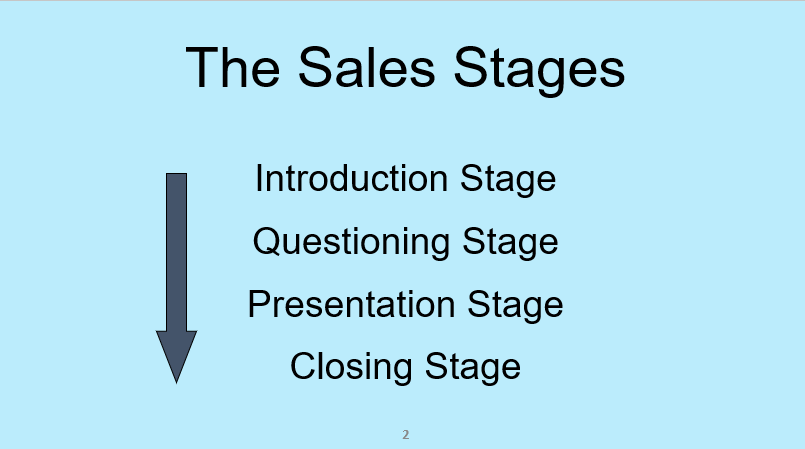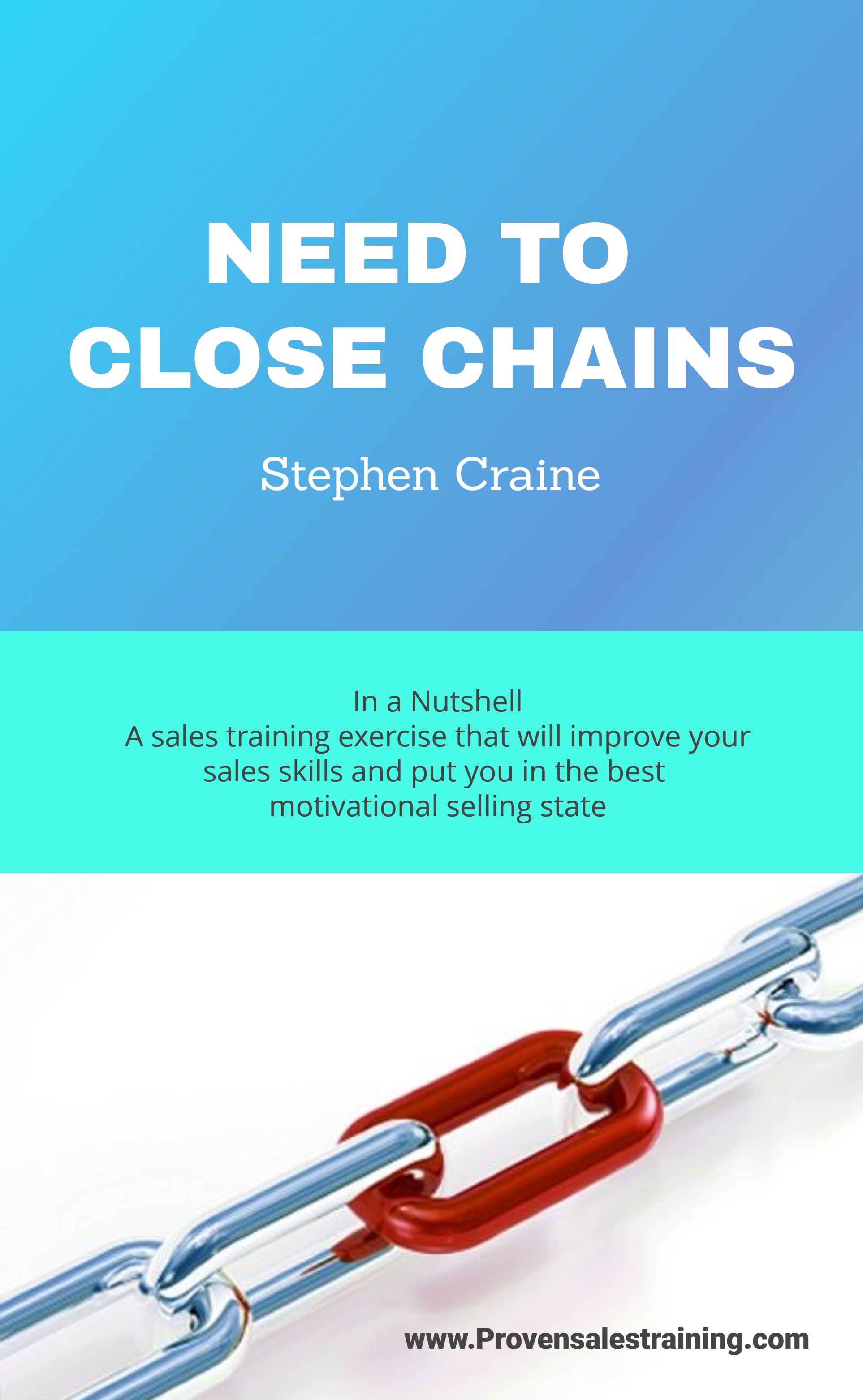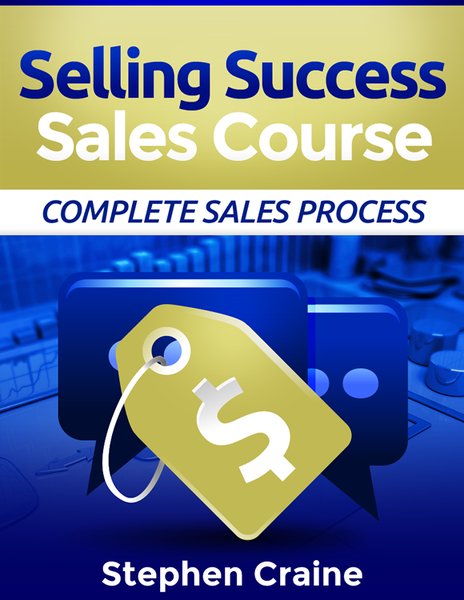sales presentations stage
of the sales process
The Sales Presentations Stage is where you show the prospect your solution, proposal, demonstration, or next step to meet their needs, wants, and desires discovered in the Questioning Stage of the sales process.
Stage 3 of the Sale Process...
 Slide from the sales training course Selling Success
Slide from the sales training course Selling SuccessYour sales presentation could be a quick verbal explanation of the relevant features and benefits of a simple product or service.
Or, an in depth formal presentation of a complex solution to a prospect's problem.
Whatever format you use for your prospects you want to know what to present and the best order to present it.
Focus your presentation on benefits...
Effective sales presentations include the features and benefits relevant to the requirements of the prospect, you will have discovered those requirements in the Questioning Stage of the sales process.
Here I'll show you how to present features and related benefits, and which order to present them in, by using a great sales technique that determines what is most important to the prospect.
The sales presentations techniques here have all been proven successful by the sales teams I have managed and trained, so you know they will work for you...
Sales Presentations - What to Present
If you followed the sales training I offered on the previous stage of the sales process, the Questioning Stage, you will now have one or more neat packages of topic information for your presentation.
This is the information on the prospect's needs, wants, and desires, that you gained when using the sales questioning funnel. To create effective sales presentations you must show:
- The benefits of your products or services.
- How they are delivered by the features of your products and services.
- How this provides what the prospect has told you they want in the Sales Questioning Stage.
Two important points:
- Only present the benefits and features to meet the needs, wants, and desires discovered in the Questioning Stage.
- Always present the benefit this will give the prospect, the features of the product or service that deliver the benefits, and how the benefits meet their requirements.
Never presume the prospect can see how a product or service provides a benefit, present what a product gives them and how it delivers it.
You can add additional features that give benefits you have good reason to think the prospect may want, but do not real off a long list of everything your products do. Prospects will only give you so much of their time and attention, focus on what they want and how you can give it to them.
Learn more about using Features & Benefits...
For more training on sales presentations and features & benefits, take a look at this free mini-course.
Quickly link a buyer's needs to the benefits & features of what you sell?
To sell successfully by creating effective sales presentations it is essential that you can instantly match the prospect's needs, wants, and desires to the benefits and features that can provide them.
In this free eBook mini sales training course that I created for my sales teams, you'll follow a proven process for learning to instantly respond to a buyer's needs with how your sales proposal can give them what they want.
You'll also discover many new benefits that you didn't realise the features had and add them to your sales pitches.
The Need to Close Chains is free for you as a visitor to this website, see what else it will give you at: Need to Close Chains
The Order of the Sales Presentation
You have a list of requirements the prospect wants, discovered in the Questioning Stage.
You've matched them to the benefits and features of your products and services, either mentally if the requirements are simple or in your notes if they are complex.
To give sales presentations that grab the attention and interest of your prospects you also need to know what order to present your solutions, proposals, or next steps and their related benefits.
Listen to what the prospect says first...
If you have used Wide Open Questions when discovering their needs, which don't lead the buyer and lets them choose their responses, whatever need they mention first is the most important to them. It is what's uppermost on their mind.
The order of the answers that follow will also show their level of importance. This is why it is so crucial that you start your discovery questions with Wide Open Questions that let the buyer respond with only minimal influence from you to keep them on topic.
During the Questioning Stage you will have memorised or noted their responses and the order they gave them. Now you present back to them the benefits and features to meet their requirements in the same order they presented their requirements to you. Whatever they said first is most important to them, so you present on that topic first.
Gain Agreement to Sales Presentations
Depending upon the complexity of the prospect's requirements, your sales presentations will either be brief and cover the small number of required benefits together.
Or, your presentation will include a set of mini presentations to address a longer list of varied needs.
After whichever you decide to use you should gain agreement that you met the prospect's needs, wants, and desires and they can see how they will benefit from your proposal.
If you give one all encompassing presentation, which for simple products could be so short it is done in a few lines of conversation, you can gain agreement at the end.
When giving a sales presentation covering how you will meet a longer list of varied requirements, you can gain agreement that you have addressed a particular need after each one. After a long presentation you may want to summarise and gain agreement to the whole package of benefits and features before moving on to the close.
Think of this agreement gaining as a trial sales close. You are asking if your solution, quote, proposal, is agreeable to them. Any obstacles, doubts, or objections will surface here and can be dealt with before you get to the Sales Closing Stage and ask for the order, trial, letter of intent, or agreement to whatever the next step is in your sales process.
Learn the Secrets of Creating
Successful Sales Presentations
Sales Presentations are where you communicate to buyer's why they should buy what you can offer. You show how your products and services will give them what they want, and it's where you influence their decisions.
What you have seen here on this page is just a sample of the sales techniques that can be used in successful sales presentations.
There is much more sales training and techniques you can include:
- What to say to move the prospect from the Questioning Stage to the Presentation Stage.
- Organising the information used in the presentation to have the most impact.
- The best way to present benefits and features of your products and services.
- Using evidence to support how you can give what the prospect wants.
- How sales professionals gain agreement that makes closing the sales easy.
All the above sales training on Sales Presentations is included in the course I use to train the field sales and telesales team I have managed for large corporate organisations. This course gives you everything you need to be successful in sales.
Take a look at the Selling Success course.
The Stages of the Sales Process

Get more sales training on the sales process by viewing the pages on each stage of the sales process:
An overview of the Sales Process
Sales Questioning Stage
The Sales Presentation Stage - This page
The Closing Stage
- Homepage
- The Sales Process
- Sales Presentations

